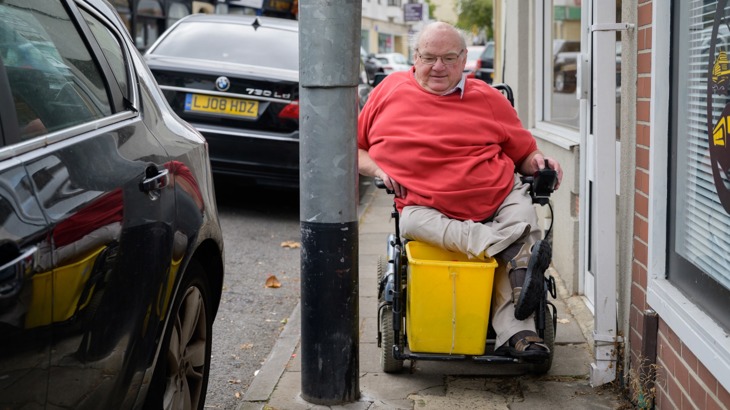The Highway Code states that vehicles should not be parked on the pavement, but this is advisory only, not enforceable. Sustrans believes that pavement parking should be made illegal across the UK unless it is permitted by exception.

Photo: Jon Bewley
Summary
- We believe pavement parking should be made illegal across the UK unless it is permitted by exception.
- Parking a vehicle partially or wholly on the pavement, however, is only illegal by default in London. Scotland has recently passed a bill that will make pavement parking illegal which should come into force soon. Pavement parking is inconsiderate to all pedestrians and is particularly hazardous to children, disabled people and older people.
- The main objection raised to bans across the UK is that there are narrow streets where there is no off-street parking nearby. Sustrans believes that in each street where there is conflict, space should first be assigned for safe pedestrian and emergency vehicle access and that any remaining space can then be allocated for parking.
Context
Pavement parking is a widespread problem.
For example, in England, 93% of local authorities have received complaints from members of the public about pavement parking.
Space in many urban places is becoming more and more constrained, as car ownership continues to rise alongside increases in home and business deliveries and car sharing platforms like Uber.
This means car parking is often displaced onto pavements and other public spaces off the carriageway.
Furthermore, a recent survey suggested that 46% of drivers are confused about the current laws on pavement parking.
Therefore many drivers park wherever they can, often on the pavement to ensure the road is still accessible.
In many places parking on the pavement is so common it has become a social norm.
Vehicles parked on pavements are a common source of inconvenience and are a hazard to pedestrians.
Often they force a wide range of vulnerable people into the road by taking up space on the footway.
This includes people with visual impairments; with people with sight loss at risk of colliding with cars parked on pavements more than any other pavement obstruction.
Older people, children, and people with reduced mobility, prams or pushchairs, can also be forced into the road and put at greater risk of collision and injury.
Pavement parking has emerged as one of the most common complaints made by people walking.
Pavements are not generally engineered to be driven on and repairs to damaged pavements are expensive, particularly at a time when councils’ resources are under huge pressure. This creates further hazards to people walking.
The current legal position
In the whole of the UK, goods vehicles exceeding 7.5 tonnes are prohibited from parking on pavements or verges, except in cases of emergency or where there is no practicable alternative for unloading.
However currently parking a smaller vehicle partially or wholly on the pavement is only against the law in London, whilst it should become illegal in Scotland soon.
In London, all vehicles are banned from parking on pavements, and the maximum fine is £100. London boroughs can designate areas that are exempt from this.
This is the opposite in UK local authorities outside of London which can designate areas of no pavement parking but this is time-consuming, expensive and bureaucratic, with areas needing to be signposted.
In the rest of the UK, the Highway Code states that vehicles should not be parked on the pavement, but this is advisory only, not enforceable.
Outside of London driving any vehicle along the pavement or causing a clear obstruction, is a criminal offence, but this is very rarely enforced by the police.
It is also an offence to park vehicles on the pavement for commercial sale or repair.
What Sustrans thinks
Sustrans believes that action is now required to ban pavement parking across the UK.
London has shown that this is a practicable option, and now that the Transport Bill in Scotland has passed, Scotland will follow suit.
In London where space is constrained, management of the space has been improved by markings to indicate precisely where car parking is acceptable.
The main objections raised to a ban across the UK are that there are narrow streets where there is no off-street parking nearby, and that access must be maintained for emergency vehicles.
We believe that in each street where this conflict occurs and an exception is considered necessary, a clear and effective 2m width should first be assigned for safe pedestrian access on each side of the road or just one side if pavement access is not required on both
Adequate width must be preserved for emergency vehicles and finally, any remaining space can be allocated for parking.
Local authorities should be given a timescale by which to introduce exceptions.
And they should be resourced properly to do so.
Police forces have other priorities and enforcement should be done most cost-effectively by local authorities.
They will also need resourcing to identify problem streets and to take appropriate measures, but resources will be freed up by no longer having to introduce complicated Traffic Regulation Orders to control parking where it has been a problem.
Our research shows that banning pavement parking would help 70% of all residents to walk or wheel more. Find out more.
Meet Mark, who is registered blind. He explains how a ban on pavement parking would vastly improve his journeys when walking with his guide dog.





